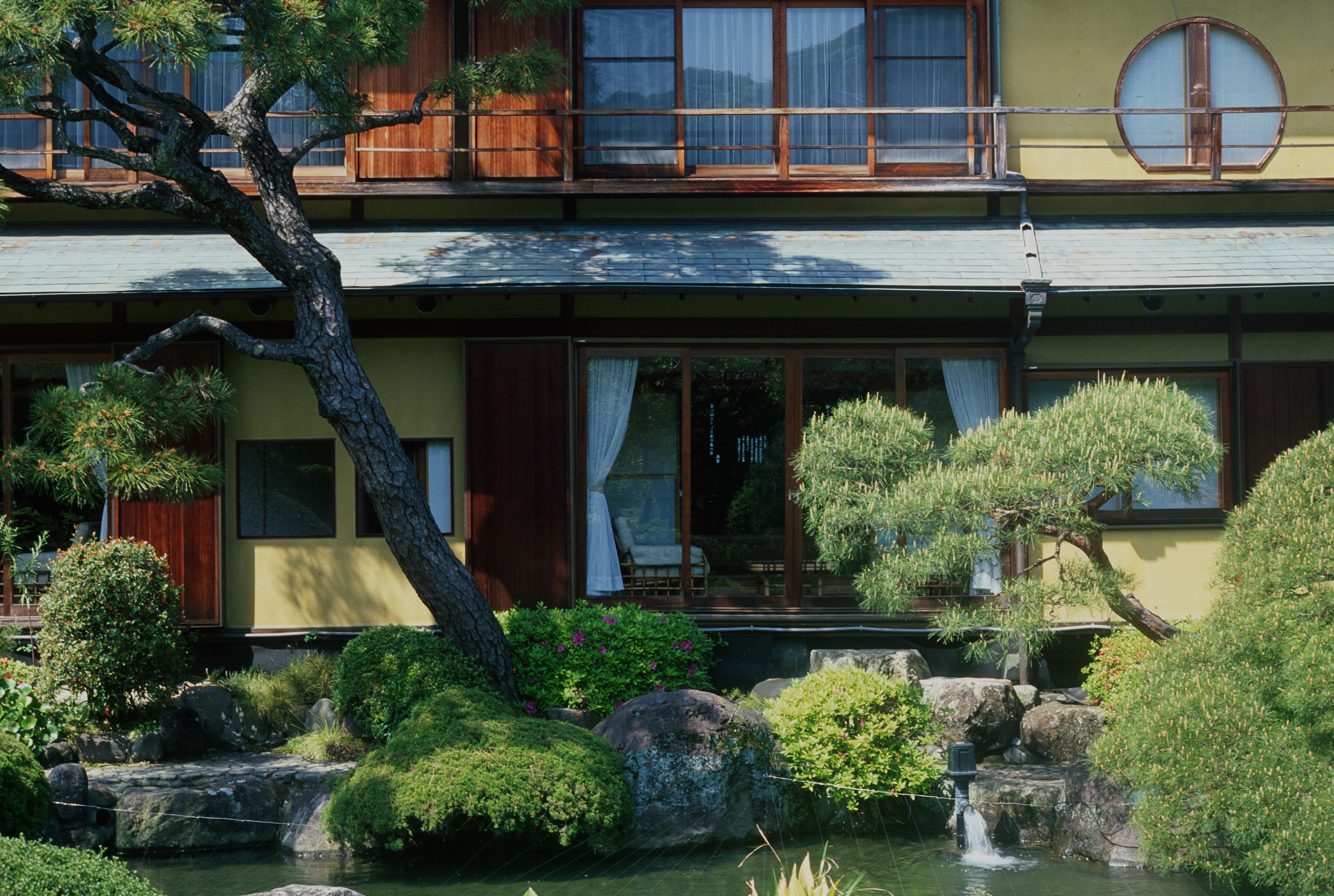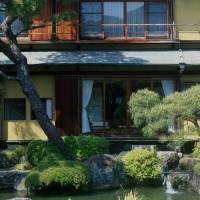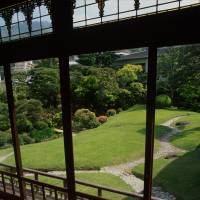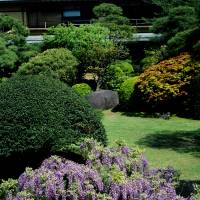Despite the seasonal limitations for visiting, the Atami Baien, a plum garden, is a better-known sight that the Kiun-Kaku garden, which is an all-seasons landscape also found in Atami, Shizuoka Prefecture. Perhaps it is the thirst for scale that has prioritized the plum trees in their large hillside park setting. The trend toward Western-style landscapes, especially European-style ones with strong English horticultural features, draws other visitors to the town's Akao Herb and Rose Garden.
The Kiun-Kaku is not a major garden, but neither is it obscurely minor. The ownership of decently sized plots such as this in Japan has been, and remains, the prerogative of the affluent. Japanese developers, particularly in increasingly urbanized areas like Atami, have always coveted gardens, which occupy precious real estate. The new wealthy class that commissioned the building of gardens such as Kiun-Kaku were often business leaders, an empowered nouveau riche with an interest in Western styles of gardening, but with an abiding nostalgia for late Edo Period (1603-1867) aristocratic gardens, and the early Meiji Era (1868-1912) landscapes of their youth. While it was originally built by a shipping magnate in 1919, the railroad tycoon Kaichiro Nezu, added extra touches during the 1930s.
Referring to the lush diversity of the natural landscape in this country, and its reshaping by man, the English poet James Kirkup wrote of the "neat, tremendous garden of Japan." Creating order from the unmanaged elements of nature had a special appeal to Japan's wealthy, who were the new architects of change.
By the time Kiun-Kaku was conceived, some of the infatuation with Western gardens and design forms had waned, and landscape designers were once again reasserting their identity by integrating both foreign and indigenous forms in their projects. This pliability is perfectly acceptable in garden design, providing the results are inspiring. Teiji Itoh, an important garden scholar, wrote that it was permissible to see "distorted versions of foreign ideas existing side by side with primitive, indigenous garden forms."
Although lawns had been grown in Japanese gardens such as Korakuen in Okayama City, and as grass mounds in landscapes like the Suizenji Joju-en, an Edo Period garden in Kumamoto, lawns were used in the grounds of villas such as the Kiun-Kaku to promote the feeling of a parkland.
In an interesting fusion of the Heian Period (794-1185) passion for flowering plants, shrubs and trees and a comparable fondness for such things in the West, a greater diversity of vegetation appeared in Japanese gardens from the Meiji to Taisho (1912-26) years. There always seems to be something to look at in the grounds of the Kiun-Kaku, with azaleas, wisteria, Japanese quince and fragrant olive among the flowering shrubs and bushes. Many of the garden's miniature foreground trees, and taller ones lending background and peripheral density, are evergreens.
Unlike the circuit gardens of the Edo period, or some of the better-appointed temple gardens of Kyoto, there are no shakkei ("borrowed views" of the surrounding landscape) here. The garden enfolds upon itself, promoting an air of privacy and privilege. The presence of atypically large stone lanterns, almost oversized kutsu-nugi-ishi (shoe-removing stones) and raised water basins align the garden with the touch of hubris that made such objects status symbols during the late Meiji and Taisho eras.
Parts of the garden, particularly the sloping lawns segmented by winding stone paths leading to shallow ponds, bear a striking resemblance to the Seifu-so in Kyoto, a property currently managed by Kyoto University. Clearly, there was a good deal of cross-fertilization during this period, aided by improved transportation systems, which provided designers with more opportunities to view gardens.
There are some minor lapses of taste here, such as the inclusion of a bronze crane statue, its figure stooping over the edge of a pond, but discernment wins out in the overall scheme of the garden. And the fusion of interior and exterior, a feature of Japanese gardens and structures such as temples and private homes, is skillfully managed.
Scale and congruity are as well considered in the compositions of gardens as they are in the traditional architecture of Japan. In the best instances, environment and architecture converge. The harmony between interior and exterior is achieved with some interesting materials and design touches at Kiun-Kaku. Instead of the customary expanse of tatami mats, cantilevered above the garden like an infinity pool, here we have small colored floor tiles, lending a neo-Moorish atmosphere to one room. Somehow, where you would expect opposition, symbiosis is achieved.
The garden, then, is a Taisho creation with the residual characteristics of more dominant Meiji Era designs. The period in which the garden was made is notable for its poor level of garden scholarship, which had come to a virtual standstill at the time. Japanese garden design was no longer regarded as an art. Gifted garden designers were liberated from the models of the past, the less talented free to create substandard works.
In this aesthetic and conceptual hiatus, themes, symbolism and abstraction receded, as the gardens of the newly wealthy reverted to their Heian Period purpose of being extensions of aristocratic homes. If there was any theme at all during this period of early 20th century Japanese garden design, it was the transition of nature as art to naturalism. As garden scholar Gunter Nitschke expressed it, "The selective, reductive, abstractive hand of the designer was to remain hidden so that the garden might appear a perfect icon of nature."
Mercifully, the Kiun-Kaku is a meticulously conceived work, one that took into account not just the wishes of its owners, but the natural landscape that forms this well-ventilated plot. To design gardens such as this, fully exploiting a sloping terrain, you have to be both planner and field technician.
The use of water in townhouse gardens was something of an innovative step in the Meiji Period, retaining its novelty value up to the time when the Kiun-Kaku landscape was created. When this garden was completed, the slopes of Atami were far less congested than they are today with the effects of urban encroachment. A popular location for the second homes of the wealthy, and smaller but exquisite residential garden plots of writers such as Junichiro Tanizaki, Atami boasted at that time a good deal more evidence of nature. Kiun-Kaku, with its self-contained serenity, has managed to preserve the tastes and values of that period.
4-2 Showa-cho, Atami-shi, Shizuoka-ken; 0557-86-3101; www.city.atami.shizuoka.jp/page.php?p_id=893; open 9 a.m.-5 p.m. (closed Wed.); ¥500. Stephen Mansfield's latest book is "Japan's Master Gardens: Lessons in Space and Environment."






